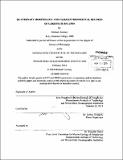Quaternary morphology and paleoenvironmental records of carbonate islands
Author(s)
Toomey, Michael (Michael Ryan)
DownloadFull printable version (13.08Mb)
Other Contributors
Woods Hole Oceanographic Institution.
Advisor
Jeffrey Donnelly.
Terms of use
Metadata
Show full item recordAbstract
Here I use a simple numerical model of reef profile evolution to show that the present-day morphology of carbonate islands has developed largely in response to late Pleistocene sea level oscillations in addition to variable vertical motion and reef accretion rates. In particular, large amplitude 'ice-house' sea-level variability resulted in long lagoonal depositional hiatuses, producing the morphology characteristic of modern-day barrier reefs. Reactivation of carbonate factories, transport of coarse reef material and rapid infilling of shallow water accommodation space since deglaciation makes these unique sites for reconstructing Holocene climate. Integration of new tropical cyclone reconstructions from both back-barrier reef (central Pacific) and carbonate bank (the Bahamas) settings with existing storm archives suggests a coordinated pattern of cyclone activity across storm basins since the late Holocene. Seesawing of intense tropical cyclone activity between the western Pacific (-0- 1000 yrs BP) and North Atlantic/Central Pacific (~1000 ~2500 yrs BP) appears closely tied with hydrographic patterns in the tropical Pacific and El Niflo-like variability. Decoupling of North Atlantic (inactive) and South Pacific (active) tropical cyclone patterns during the mid-Holocene suggests precession driven changes in storm season insolation may constrain ocean-atmosphere thermal gradients and therefore cyclone potential intensity on orbital timescales.
Description
Thesis: Ph. D., Joint Program in Marine Geology and Geophysics (Massachusetts Institute of Technology, Department of Earth, Atmospheric, and Planetary Sciences; and the Woods Hole Oceanographic Institution), 2014. Cataloged from PDF version of thesis. Includes bibliographical references.
Date issued
2014Department
Joint Program in Marine Geology and Geophysics; Woods Hole Oceanographic Institution; Massachusetts Institute of Technology. Department of Earth, Atmospheric, and Planetary SciencesPublisher
Massachusetts Institute of Technology
Keywords
Joint Program in Marine Geology and Geophysics., Earth, Atmospheric, and Planetary Sciences., Woods Hole Oceanographic Institution.